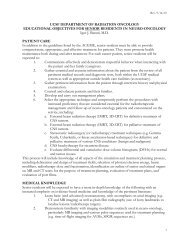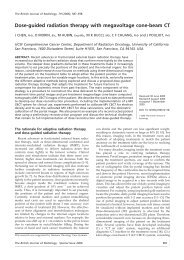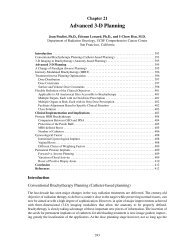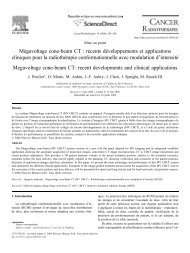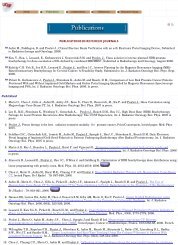Soft Tissue Visualization Using a Highly Efficient Megavoltage Cone ...
Soft Tissue Visualization Using a Highly Efficient Megavoltage Cone ...
Soft Tissue Visualization Using a Highly Efficient Megavoltage Cone ...
Create successful ePaper yourself
Turn your PDF publications into a flip-book with our unique Google optimized e-Paper software.
Two image receptors that were used for this study contained two components; a metal build up<br />
plate/phosphor screen and a flat panel imager. The flat panel imager had an active area of 41 x 41 cm 2 , and<br />
contained 1024 x1024 elements of 0.4 mm pitch. The fastest frame rate was 7 frames per second and the<br />
output data was 16-bit. Flat panel detectors generate frames either using “Free Running” or “External<br />
Triggered”. Free running means that the detector sends out continuous frames according to the selected<br />
frame time. External triggered means that there is an external trigger which allows the generation of the<br />
maskable interrupt request.<br />
The phosphor screen of one receptor (receptor 1) was a 133 mg/cm 2 Gd 2O 2S screen (Lanex Fast) and for<br />
the receptor 2 was an 800 µm CsI (TI) scintillator screen. Both receptors were using a 1mm copper buildup<br />
plate. The charge amplifier capacitance of receptors 1 and 2 were 5pF and 1pF, respectively.<br />
2.3 <strong>Cone</strong> Beam Image Acquisitions and Corrections<br />
<strong>Cone</strong> beam CT starts by acquiring a large number of projection images acquired as the X-ray source<br />
follows an orbital path. At every angular increment, i.e., every degree, an image is acquired. 201<br />
projections were acquired over 201 degrees (1° rotation between projections) around the subject. The<br />
gantry speed was set to 109° per minute.<br />
The Siemens PRIMUS® linear accelerator parameters were adjusted to allow the delivery of a small<br />
fraction of a Monitor Unit (MU) per image. A very precise dose control was achieved by loading the<br />
accelerator by very small amount of electrons per pulse. In the current design, the injection is phased with<br />
the RF power at startup or during re-phasing of the injector at the programmed angular increment. With<br />
normal beam parameters, the phasing or re-phasing of the injection generates a shift in the resonant<br />
frequency of the accelerator. Because of the lag of the automatic frequency control (AFC), the beam<br />
formation can be significant (hundreds of milliseconds). In order to improve the beam formation, the beam<br />
parameters were adjusted such that the dose per pulse was reduced to approximately 10% of normal, and<br />
the pulse repetition frequency (PRF) was adjusted to 250 pps. The reduced loading resulted in an<br />
insignificant shift in the resonant frequency of the accelerator, resulting in significant improvement of the<br />
beam formation (less than a few ms). The increased PRF improved the granularity of the control system,<br />
the significance of every dose pulse was reduced, the predictability of the system increased, and the beam<br />
formation time decreased to only several milliseconds.<br />
Three corrections were performed; Offset, Gain, and Defected pixel correction. Offset correction is used to<br />
correct the dark current of each pixel for a specified frame or integration time. The integration time for each<br />
projection is equal to the projection period (figure-1), and therefore, the Offset correction images were<br />
acquired with the frame time that is equal to the projection period.<br />
The Gain correction is used to homogenize the flat field image intensity. The Defected pixel correction<br />
allows a software repair of defected pixels to enhance image quality. Improper pixel values are replaced<br />
with the averaged value of the adjacent pixels, while defected pixels are not averaged.<br />
2.4 Preprocessing by Resolution/Dose Adaptive Filter<br />
A unique adaptive noise removal filter was used for image enhancement 2 . The filter utilizes pixel-wise<br />
nonlinear and adaptive techniques to estimate the additive noise power before filtering. The characteristics<br />
of the filter are adapted to the input X-ray flux and image spatial resolution. Filtering is minimal to the<br />
images that receives high X-ray flux, and increases with the decreasing flux. To minimize the loss of<br />
resolution, minimum filtering is applied to the area of an image with large variance to preserve the edges<br />
and other high frequency components of an image 2 .<br />
Before data normalization and reconstruction, the corrected projection images (Offset, Gain, and Defected<br />
pixel) were processed by the resolution/dose adaptive filter using a local matrix size of 8x8.<br />
2.5 Data Normalization and Reconstruction




